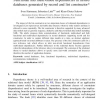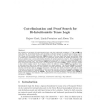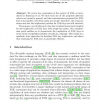112
click to vote
ACL
2012
13 years 2 months ago
2012
The importance of inference rules to semantic applications has long been recognized and extensive work has been carried out to automatically acquire inference-rule resources. Howe...
181
click to vote
ICAIL
2011
ACM
14 years 1 days ago
2011
ACM
A formal two-phase model of democratic policy deliberation is presented, in which in the first phase sufficient and necessary criteria for proposals to be accepted are determine...
101
click to vote
ICDIM
2010
IEEE
14 years 10 months ago
2010
IEEE
In this paper, we discuss the use of digital circuits in decision support systems. For this, it is first necessary to translate the descriptions of situations and conclusions whic...
120
click to vote
JAIR
2007
15 years 10 days ago
2007
Exact Max-SAT solvers, compared with SAT solvers, apply little inference at each node of the proof tree. Commonly used SAT inference rules like unit propagation produce a simpli�...
112
click to vote
AMAI
2006
Springer
2006
Springer
Functional and multivalued dependencies in nested databases generated by record and list constructor
15 years 15 days ago
tor. In order to capture different data models at a time, an abstract algebraic approach based on nested attributes is taken. The presence of the list constructor calls for a new i...
108
click to vote
CORR
2010
Springer
15 years 16 days ago
2010
Springer
We consider an extension of bi-intuitionistic logic with the traditional modalities , , and from tense logic Kt. Proof theoretically, this extension is obtained simply by extendin...
110
Voted
COLING
1996
15 years 1 months ago
1996
This paper describes an operational semantics for DATR theories. The semantics is presented as a set of inference rules that axiomatises the evaluation relationship for DATR expre...
107
click to vote
IJCAI
2007
15 years 1 months ago
2007
In this paper we present a general logical framework for (weighted) MAX-SAT problem, and study properties of inference rules for branch and bound MAX-SAT solver. Several rules, wh...
121
Voted
EMNLP
2007
15 years 1 months ago
2007
Semantic inference is a core component of many natural language applications. In response, several researchers have developed algorithms for automatically learning inference rules...
104
Voted
ICDT
2007
ACM
15 years 4 months ago
2007
ACM
Abstract. We review key constraints in the context of XML as introduced by Buneman et al. We show that one of the proposed inference rules is not sound in general, and the axiomati...



